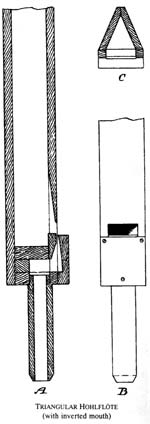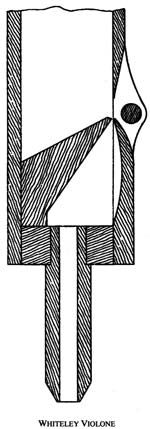Organ voices
* See postscript
So how would YOU describe the sound of a pipe organ to a deaf person? David Bridgeman-Sutton considers the sounds of smashing glass, seaweed and balls of fluff as possibilities
|
"When heard from the choir .... its tone is very like a fine Pedal diapason combined with a soft 16-feet reed of equal quality and intonation." Thus Hopkins and Rimbault describe the violone on the organ at Cologne cathedral in 1877. Organ lovers can have no difficulty in "hearing" that sound in their minds. "A blazing (or fiery) trumpet " can well be imagined and, thanks to CDs, the characteristics of a "Schulze-like diapason chorus" are easily identified. "Cathedral roll", was universal shorthand for an effect dominated by large -scale 8' and 16' stops, much praised in the earlier years of the twentieth century . By contrast, Hugh Allen, whose books on harmony and counterpoint still appear on many bookshelves as standard texts, dismissed the sound of baroque instruments as "bubble and squeak".
The Victorian concert organist, W.T. Best, on hearing a singularly aggressive railway-engine whistle, told Father Willis that it reminded him of one of the latter's Harmonic Flutes ~ but the two were not on good terms at the time. |
|
Growing interest in pipe organs has resulted in increasing numbers of writers of articles discovering how hard it is to find the right words to describe the timbre of stops and choruses and there have been numbers of conspicuous failures.
Try to identify the qualities described below:- (a) the sound of smashing glass; (b) a sound like green seaweed on a gently-ebbing tide; (c) the tone is reminiscent of a ball of fluff with spikes sticking out of it. |
|
Smashing glass refers, of course, to over-eager mixtures on the Swell. This seemed an exaggeration, until, one day, a player given to marked dynamics played a rapid crescendo followed immediately by an equally fast diminuendo. This, on full swell with the octave-coupler added produced an effect that would have delighted any old-time theatre organist called on to suggest that a sack of bricks was being dropped on to a conservatory from a passing aeroplane. No more exact description of the sound than "smashing glass" could be imagined.
The gently-ebbing tide gives (b) a clue to the undulations of string stop drawn with the voix celestes. Did the writer intend green seaweed as a compliment or was he implying that the tone made him sick? No one knows and the sound (if any) of seaweed is an area yet to be researched. (c) the spiky balls of fluff come from Noel Bonavia Hunt's 1923 volume on Modern Organ Stops. NBH was a skilled voicer whose duties as a parson caused him to recline with regret many of the commissions offered to him - including work on the organ at Philadelphia's Wanamaker store. Existing examples of his work show extreme refinement of tone and perfect balance throughout the compass. |
The stop he thus describes is the Horn Diapason - one of those hybrids usually found only in large organs where cost has been no consideration. It also occurs in smaller ones where reedy-toned flues are preferred to actual reed pipes on account of their greater ability to stand in tune. Voicers must hear pipes differently from less-gifted mortals; the sound of spiky balls of fluff are as elusive as that of seaweed.
Why not try clicking on "Listen" on this web-site and playing the extract from Meyerbeer's Coronation March. (Better still, if you have the disc, play the whole track.) The solo stop used is the Bombarde. Can this be described in words in such a way that a non-musician would gain some idea of what it sounds like?
If you like to send your description in, we'll try to show it here - anonymously if you prefer.
Why not try clicking on "Listen" on this web-site and playing the extract from Meyerbeer's Coronation March. (Better still, if you have the disc, play the whole track.) The solo stop used is the Bombarde. Can this be described in words in such a way that a non-musician would gain some idea of what it sounds like?
If you like to send your description in, we'll try to show it here - anonymously if you prefer.
David Bridgeman-Sutton,
2002
2002
A postscript !
The August 2002 number of Organists' Review has on its cover, as usual, a most attractive photograph. This shows the new Harrison & Harrison instrument in Front Street Methodist Church, Burlington, North Carolina. The elegant colonial building is now graced by a handsome pair of organ cases in classical style that blend with the overall design.
On page 238, Harrison's advertisement features this new organ, giving specification and background information, including details of wind pressures - "12" for the grandiloquent tuba".
Using the contact facility on the firm's website I rather cheekily suggested that "grandiloquent" was not the right word, quoting the Oxford Dictionary's definition as "pompous in language - given to grand talk" with its suggestion of the meretricious and unreliable.
Mark Venning, Harrison's Managing Director, replied:-
"I claim the authority of Cicero and Virgil for the use of this fine word to mean "speaking grandly or in a stately fashion". It is a pity that the slightly pejorative meaning seems to prevail in modern English, but I feel it is good to resist such tendencies."
No tubas speak more grandly than those that come from H&H's Durham factory and it is always a pleasure to meet the elegant and well-informed use of words. As this exchange illustrates, semantic problems can occur when describing organ tones. Resisting current usage, perhaps, creates others.
One thing is certain. If either Cicero or Virgil is in the market for a new pipe organ, Harrisons will enter the tendering process with a head start.
The August 2002 number of Organists' Review has on its cover, as usual, a most attractive photograph. This shows the new Harrison & Harrison instrument in Front Street Methodist Church, Burlington, North Carolina. The elegant colonial building is now graced by a handsome pair of organ cases in classical style that blend with the overall design.
On page 238, Harrison's advertisement features this new organ, giving specification and background information, including details of wind pressures - "12" for the grandiloquent tuba".
Using the contact facility on the firm's website I rather cheekily suggested that "grandiloquent" was not the right word, quoting the Oxford Dictionary's definition as "pompous in language - given to grand talk" with its suggestion of the meretricious and unreliable.
Mark Venning, Harrison's Managing Director, replied:-
"I claim the authority of Cicero and Virgil for the use of this fine word to mean "speaking grandly or in a stately fashion". It is a pity that the slightly pejorative meaning seems to prevail in modern English, but I feel it is good to resist such tendencies."
No tubas speak more grandly than those that come from H&H's Durham factory and it is always a pleasure to meet the elegant and well-informed use of words. As this exchange illustrates, semantic problems can occur when describing organ tones. Resisting current usage, perhaps, creates others.
One thing is certain. If either Cicero or Virgil is in the market for a new pipe organ, Harrisons will enter the tendering process with a head start.
(With thanks to Warwick Henshaw for the pictures from Bardon Enterprises' recent reprint of Noel Bonavia-Hunt's Modern Organ Stops originally published in 1923.)




